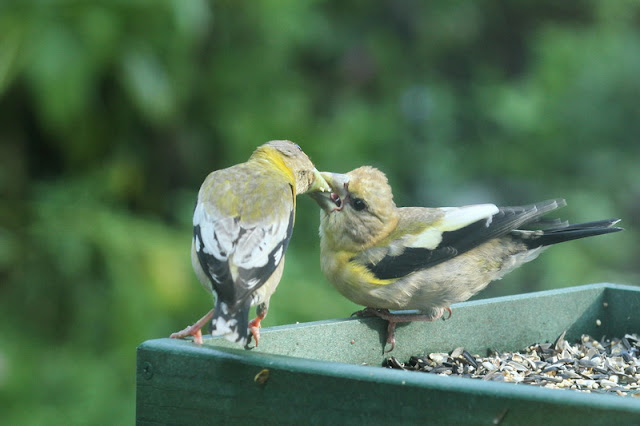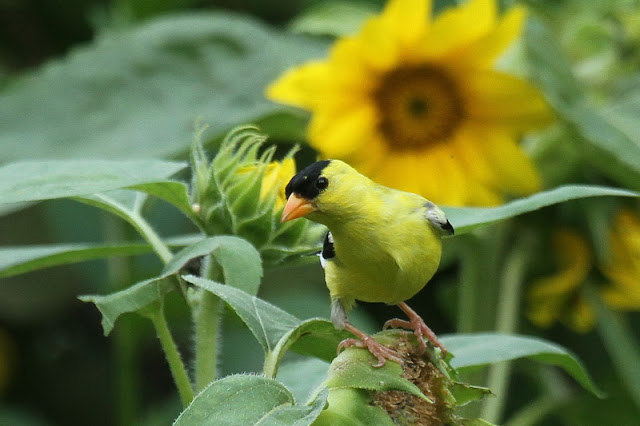The breeding season for the birds is just about over. In my yard it has been a successful and entertaining season, with a succession of young birds being fed in the trees and bushes, and around the feeders. But what I see in my yard is just a fraction of the activity, challenges, and drama of the breeding birds.
 |
| American Robin with two fledglings |
As an example, let’s begin with a few dry facts about the American Robin. The male and female build a cup nest from scratch. Typically four eggs are laid and are incubated by the female for two weeks. The young are fed in the nest for two weeks and are then fed by both parents as fledglings. A pair of robins will raise two or three broods each year.
Now consider: if every egg hatches and every hatchling fledges and every fledgling survives, this would mean that a single pair of robins would add eight to twelve new robins to the robin population in a single year. If all robins were similarly successful, the robin population would increase on average five times in one breeding season. Clearly, we would soon be overrun with robins.
 |
| Rose-breasted Grosbeak fledgling flutters and calls for food |
But that degree of nesting success rarely occurs. The eggs and the nestlings of birds are threatened by many predators: weasels, raccoons, red squirrels, snakes, jays, crows, hawks, and owls (to name just a few). And don’t forget your house cat among the predators. Birds are hosts to many parasites; bird-lice, fleas, louse flies, ticks, and mites all dine on the birds and their young. Storms can damage nests. If the nest has been built anywhere near humans, deliberate or inadvertent disturbance may occur. Once the young are out of the nest, the dangers increase. Young birds are squawking and fluttering to attract the attention of their parents so that they can be fed, but this may also attract the attention of all of those nest predators and more.
Food supplies effect the ability of birds to successfully raise young. A few years ago, cuckoos were common in our area, in conjunction with a variety of caterpillars chewing up the leaves of the trees. Several years ago, our yards were overrun with chipmunks. That same summer, Barred Owls had remarkable success in raising their young. But then came the winter when the food disappeared beneath the snow pack and the young owls were unable to feed themselves. A few were found and taken to wildlife rehabilitation centers; the others perished. This summer has been another banner year for chipmunks, and probably for owls and hawks as well. What will happen to those young if the coming winter is typically harsh?
The likelihood that a nesting pair of birds will successfully hatch and raise a full clutch is quite low: an egg may not hatch, a nestling may be out-competed for food by its nest mates, a fledgling may be too quiet or too weak to attract a parent with food or simply get too far away from its parents. Cornell Lab or Ornithology has citizen scientists doing nest box studies. For the Eastern Bluebird, for example, nesting success is about 72%; this is the percentage of nests that produce at least one fledgling.
 |
| Tufted Titmouse juvenile |
When I see young birds being fed around my feeders or in the trees around my home, I am seeing young that have already beaten many odds, but who still have many long odds still to overcome. In mid-July, I was entertained by a pair Evening Grosbeaks. One was the mother; the other a youngster. He was constantly calling for her. When she fed him and flew off, he followed her noisily. Eventually, he followed her to the bird feeder, where she ate and occasionally fed him. Bit by bit, he got the idea that he could get food on his own, although he gave up mom’s service only reluctantly.
The next day, the young grosbeak was at the feeder by himself and feeding himself, endlessly scarfing down seed and even chasing off other, sometimes larger, birds. But he had no sense of fear. I approached to within three feet and felt as though I could have picked him up, he was so tame - or perhaps, clueless. Instead, I clapped my hands and shouted. This finally induced him to fly off. Young Downy Woodpeckers on the suet feeder also show a cluelessness to danger, so I’ve taken to chasing them off as well in an attempt to teach a bit of wariness.
They need wariness, as the pile of dove feathers on the back lawn one morning testified. Probably a young Mourning Dove roosted on the tree branch too long, and became a meal for a hawk or owl. But in doing so, that dove fulfilled its life purpose; it became a part of the food chain.
Therein is a truth that is an unpleasant one for many people. We look on the birds at our feeders as entertainment, cute bundles of energy and activity. We give them human attributes. The titmice are sweet, the chickadees acrobatic, and the nuthatches comic. The crows are noisy and the jays are greedy bullies. But they are all “our” birds.
 |
| Blue Jay juvenile |
Watch all of them more closely. Once the young are cut free from parental dependence, the birds may occasionally cooperate in alerting others to danger, as when a hawk is perched in a nearby tree. They may travel in flocks, communicating with one another about food sources, and benefitting from safety in numbers. But they are also competing with one another for food, regardless of how full the feeders may be or how laden with fruit the bushes are. One bird chases off another bird - its own kind and other kinds - as though the food supply might suddenly run out.
The life expectancy of small birds is not long. Occasionally a song bird may live 5 to 10 years. The host of dangers and challenges facing small birds probably means that few ever “die of old age,” though old age may eventually weaken them or slow them so that they succumb to one of the dangers or challenges. Some studies suggest that only 20% of the birds which are successfully raised during a breeding season survive to the second year, while 80% of the adults survive to the following year. Clearly, mortality among small birds is very high.
Early this month, I was entertained by a young Chipping Sparrow which begged from a Song Sparrow, then begged from another young Chipping Sparrow, and eventually was fed by a parent. I am amused by the demanding calls of the young Blue Jays; they seem like the noisiest, most obnoxious juveniles imaginable. I am taken by the simple naivete of the young birds and wish them well even as I try to teach them a few lessons about getting on in the world.
 |
| Male Downy Woodpecker feeds his fledgling son |
But then I consider the realities behind my entertainment. The cycles of nature are not there for my amusement. They are serious business for the life involved. I may occasionally cite dry facts about common breeding birds, but those dry facts point to the larger challenge which each species and its individuals face in the cycle of life.











































